Air aerial fitness is a dynamic and exhilarating form of exercise that combines elements of yoga, dance, and acrobatics. This unique discipline involves using aerial silks, hoops, trapezes, and other suspended apparatus to perform a variety of challenging and graceful movements.
Whether you’re seeking a new way to improve your strength, flexibility, and balance or simply looking for a fun and exciting workout, air aerial fitness offers a rewarding experience for individuals of all fitness levels.
Air aerial fitness classes are typically conducted in studios equipped with specialized equipment and instructors who are trained to guide participants through a variety of poses and techniques. The classes often incorporate elements of yoga, Pilates, and other fitness disciplines, creating a comprehensive workout that targets multiple muscle groups and enhances overall fitness.
What is Air Aerial Fitness?

Air aerial fitness is a dynamic and engaging form of exercise that combines elements of dance, gymnastics, and yoga, all performed while suspended in the air. It originated in the early 2000s as a fusion of circus arts and fitness practices, gaining popularity for its unique blend of strength, flexibility, and artistry.
Types of Air Aerial Fitness Classes
Air aerial fitness encompasses various disciplines, each offering a distinct experience and challenge.
- Aerial Yoga: This practice integrates traditional yoga poses with the use of a suspended hammock. The hammock provides support and resistance, allowing for deeper stretches and inversions, while also promoting relaxation and stress relief.
- Aerial Silks: This captivating form involves using long, flowing fabric suspended from the ceiling. Participants climb, twist, and flip through the air, developing upper body strength, core stability, and impressive aerial skills.
- Aerial Hoop: Also known as Lyra, this discipline utilizes a circular metal hoop suspended from the ceiling. Participants perform acrobatic movements, spins, and inversions, enhancing flexibility, coordination, and body awareness.
- Aerial Trapeze: This exhilarating form features a swinging bar suspended from the ceiling. Participants learn to swing, climb, and perform aerial maneuvers, building strength, agility, and courage.
Benefits of Air Aerial Fitness
Air aerial fitness offers a multitude of physical and mental benefits.
- Improved Strength and Flexibility: The constant suspension and weight-bearing movements engage multiple muscle groups, promoting increased strength and flexibility throughout the body.
- Enhanced Balance and Coordination: The aerial environment challenges balance and coordination, leading to improved proprioception and spatial awareness.
- Increased Core Strength: The constant engagement of the core muscles is essential for stability and control during aerial movements, resulting in a stronger and more defined core.
- Improved Cardiovascular Health: The dynamic movements and increased muscle engagement elevate heart rate, promoting cardiovascular health and endurance.
- Stress Relief and Mental Well-being: The combination of physical exertion, mindfulness, and the sense of freedom in the air can be incredibly therapeutic, reducing stress and improving mental well-being.
Equipment and Safety: Air Aerial Fitness
![]()
Air aerial fitness relies on specialized equipment that allows participants to perform gravity-defying movements safely and effectively. Understanding the equipment and adhering to safety procedures is crucial for a positive and injury-free experience.
Equipment Used in Air Aerial Fitness
The primary equipment used in air aerial fitness includes aerial silks, hoops, trapezes, and harnesses. Each piece of equipment serves a specific purpose and offers unique challenges and benefits.
- Aerial Silks:These long, flowing fabrics are suspended from the ceiling and allow for a wide range of movements, including climbs, drops, and inversions. The silks are made from durable materials such as nylon or polyester, and they can be adjusted in length to accommodate different heights.
- Aerial Hoops:Also known as lyra, aerial hoops are circular metal frames suspended from the ceiling. They offer a variety of movements, including spins, hangs, and inversions. The hoops are often padded for comfort and safety.
- Aerial Trapezes:These are metal bars suspended from the ceiling, similar to traditional trapezes. They provide a platform for various acrobatic movements, including swings, drops, and flips. Trapezes come in different sizes and shapes, depending on the desired movements.
- Harnesses:Harnesses are essential safety equipment used in air aerial fitness. They are worn around the waist and legs and provide secure attachment to the equipment. Harnesses are made from durable materials and are designed to distribute weight evenly, ensuring safety during aerial maneuvers.
Equipment Maintenance and Safety Procedures
Proper equipment maintenance and safety procedures are paramount in air aerial fitness. Neglecting these aspects can lead to equipment failure and potential injuries.
- Regular Inspections:All equipment should be inspected regularly for signs of wear and tear, including frayed ropes, loose bolts, and damaged fabric. Any defects should be addressed promptly to prevent accidents.
- Proper Storage:When not in use, equipment should be stored in a dry and clean environment, away from direct sunlight and moisture. This helps prevent damage and extends the lifespan of the equipment.
- Safe Handling:It’s essential to handle equipment carefully and avoid sharp objects or rough surfaces that could cause damage. When using silks, avoid dragging them on the floor, as this can weaken the fabric.
- Professional Maintenance:It’s recommended to have equipment professionally inspected and maintained at least once a year by qualified technicians. This ensures that the equipment is in good working order and meets safety standards.
Choosing the Right Equipment
When choosing equipment for air aerial fitness, it’s crucial to consider factors such as the intended use, the level of experience, and the physical capabilities of the participants.
- Quality Materials:Opt for equipment made from high-quality materials that are durable and resistant to wear and tear. This ensures the safety and longevity of the equipment.
- Proper Fit:The equipment should be the right size and fit for the participants. Harnesses should be adjusted properly to ensure a secure fit and prevent discomfort.
- Safety Certifications:Choose equipment that meets safety standards and has been certified by reputable organizations. This provides assurance that the equipment has been tested and meets safety requirements.
Getting Started with Air Aerial Fitness
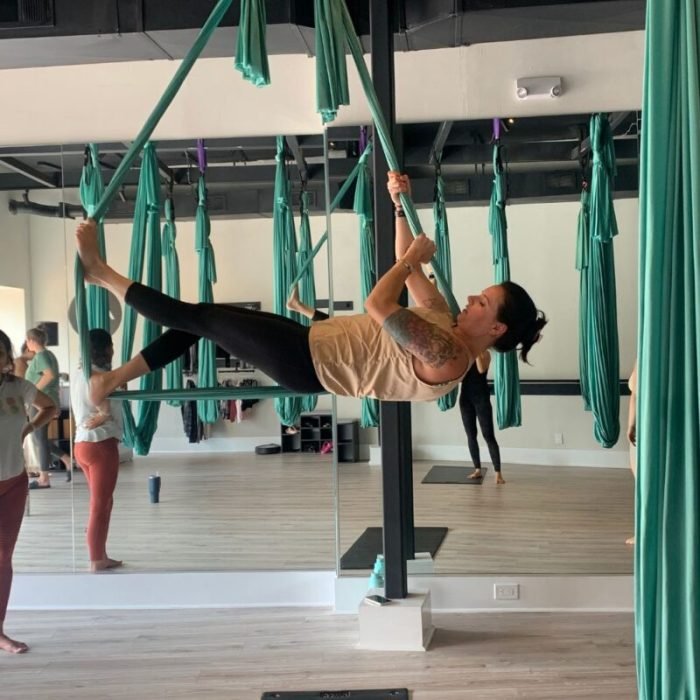
Taking the plunge into the world of air aerial fitness is an exciting adventure. Whether you’re a seasoned athlete or a curious beginner, finding the right class and getting started is crucial. This section will guide you through the process, from finding a suitable class to mastering the basics.
Finding an Air Aerial Fitness Class
Finding an air aerial fitness class is the first step in your journey. Look for classes that cater to your fitness level and goals. Consider the following tips:
- Check Local Gyms and Studios:Many gyms and studios offer air aerial fitness classes. Contact them directly to inquire about schedules, instructor qualifications, and class levels.
- Online Platforms:Websites like ClassPass and MindBody offer a wide range of fitness classes, including air aerial fitness. Use filters to find classes near you and that meet your specific requirements.
- Social Media:Follow local fitness studios and instructors on social media to stay updated on class offerings and promotions. Many studios also post videos and photos of their classes, giving you a glimpse of the experience.
Tips for Beginners
Starting with air aerial fitness can be challenging, but with the right approach, you can progress safely and effectively. Follow these tips:
- Start with Basic Poses:Begin with simple poses like hanging from the silks, basic inversions, and simple climbs. Focus on building strength and flexibility before attempting more complex moves.
- Gradual Progression:Gradually increase the difficulty of poses and routines as you gain strength and confidence. Don’t rush into advanced moves before mastering the fundamentals.
- Listen to Your Body:Pay attention to your body’s signals. If you experience pain or discomfort, stop and rest. It’s better to err on the side of caution and avoid injuries.
Warm-up and Cool-down Routines
Proper warm-up and cool-down routines are essential for preparing your body for air aerial fitness and preventing injuries.
- Warm-up:Before class, engage in light cardio, dynamic stretching, and exercises that activate your core muscles. This will increase blood flow and prepare your body for the demands of aerial work.
- Cool-down:After class, take time to stretch and cool down. Focus on static stretches to increase flexibility and reduce muscle soreness. This will help your body recover and prevent injuries.
Techniques and Skills

Air aerial fitness encompasses a range of disciplines, each with its unique set of techniques and skills. Mastering these techniques is crucial for safe and effective practice, allowing you to progress through different levels and enjoy the full benefits of this dynamic activity.
Aerial Yoga Techniques
Aerial yoga utilizes a hammock suspended from the ceiling to support the body, enabling various poses and movements that wouldn’t be possible on the ground.
- Inversions:Aerial yoga offers a unique approach to inversions, where the hammock supports the body in a safe and comfortable way. Examples include hanging upside down with the legs extended or bent, or performing a headstand with the hammock providing support.
- Stretches and Strength Training:The hammock allows for deep stretches and strength training exercises, often involving pulling and pushing against the fabric to build muscle strength and flexibility.
- Flow and Transitions:Aerial yoga sequences often involve flowing transitions between poses, utilizing the hammock for momentum and support.
Aerial Silks Techniques, Air aerial fitness
Aerial silks, also known as aerial tissu, involves climbing, wrapping, and flowing through the air using two long pieces of fabric suspended from the ceiling.
- Climbing:Mastering the basic climbing techniques is fundamental in aerial silks. This involves using your legs and arms to ascend the fabric, employing different grips and techniques to maintain a secure hold.
- Wrapping:Aerial silks involve intricate wrapping techniques, where the fabric is used to create various shapes and poses. This requires coordination, strength, and flexibility.
- Drops and Transitions:Aerial silks incorporates dramatic drops and transitions between poses, adding an element of excitement and challenge. These movements involve controlled descents and flips, requiring trust in the fabric and proper technique.
Aerial Hoop Techniques
The aerial hoop, or lyra, is a circular apparatus suspended from the ceiling, allowing for a wide range of acrobatic and dance-like movements.
- Hangs and Holds:The aerial hoop requires a strong grip and the ability to hang and hold various positions, such as the basic “O” hang and the “inverted V.”
- Rotations and Spins:The hoop’s circular shape enables dynamic rotations and spins, both with and without the body wrapped around it.
- Drops and Transitions:Aerial hoop techniques include controlled drops and transitions between poses, often involving flips and twists.
Aerial Trapeze Techniques
The aerial trapeze, a classic circus apparatus, is a bar suspended from the ceiling, allowing for swings, flips, and aerial maneuvers.
- Swinging:Mastering the swing is fundamental in aerial trapeze, involving building momentum and control while hanging from the bar.
- Flips and Tricks:Aerial trapeze techniques include a variety of flips and tricks, such as the “back tuck” and the “front layout.”
- Catch and Release:Aerial trapeze often involves a “catch” where the performer is caught by a partner on the other end of the bar, followed by a release.
Importance of Proper Form and Technique
Proper form and technique are crucial in all air aerial fitness disciplines. They not only enhance performance but also ensure safety by minimizing the risk of injury.
Proper form and technique are essential for safe and effective air aerial fitness.
Air aerial fitness is a dynamic and challenging workout that requires strength, flexibility, and grace. While mastering aerial silks or hoops, you might want to enhance your look with vibrant, stylish hair accessories – you can find a wide range of options at flamingo beauty supplies.
From vibrant headbands to colorful clips, these accessories will add a touch of flair to your aerial routine and boost your confidence during your workout.
- Injury Prevention:Incorrect form can lead to muscle strains, ligament tears, and other injuries. Proper technique ensures that the body is aligned correctly, distributing weight evenly and minimizing stress on joints.
- Improved Performance:Correct form and technique allow you to execute movements with greater efficiency and control, maximizing the benefits of the exercise.
- Confidence and Progress:Mastering proper technique builds confidence and allows you to progress through different levels, expanding your skills and capabilities.
Benefits and Challenges
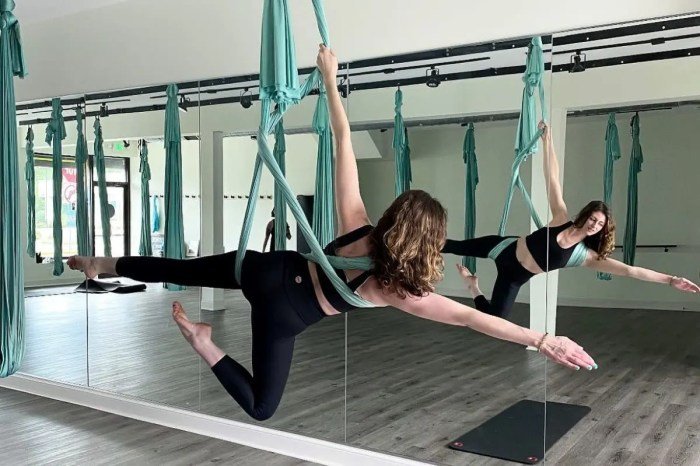
Air aerial fitness offers a unique and rewarding experience, combining strength training, flexibility, and artistry. While the benefits are numerous, it’s important to be aware of the challenges and strategies for overcoming them.
Physical Benefits
The physical benefits of air aerial fitness are significant. It is a full-body workout that engages multiple muscle groups simultaneously.
- Increased Strength and Muscle Mass:Air aerial fitness requires significant upper body strength to support your weight and perform various movements. It strengthens muscles in the arms, shoulders, back, and core.
- Improved Flexibility and Range of Motion:The dynamic movements in air aerial fitness, such as inversions and stretches, promote flexibility and increase range of motion in the joints. This can improve posture, reduce muscle tension, and enhance overall mobility.
- Enhanced Cardiovascular Health:Air aerial fitness is a physically demanding activity that elevates your heart rate, improving cardiovascular health and endurance.
- Improved Balance and Coordination:The aerial silks and hammocks require balance and coordination to maintain stability and perform movements safely and effectively. This can improve overall body awareness and coordination.
Mental Benefits
Beyond physical benefits, air aerial fitness also offers numerous mental benefits.
- Stress Relief:The physical exertion and focus required in air aerial fitness can act as a stress reliever, releasing endorphins that improve mood and reduce anxiety.
- Increased Confidence and Self-Esteem:Mastering new skills and challenging yourself physically can boost confidence and self-esteem.
- Improved Body Awareness:Air aerial fitness requires a deep understanding of your body’s movements and capabilities. This increased body awareness can translate into other areas of your life.
- Creativity and Expression:Air aerial fitness allows for artistic expression through movement and choreography. It can be a powerful outlet for creativity and self-expression.
Challenges of Air Aerial Fitness
While air aerial fitness offers many benefits, it also presents some challenges.
- Fear of Heights:One of the biggest challenges for beginners is fear of heights. This fear can be overcome gradually with practice and support from instructors.
- Strength Limitations:Air aerial fitness requires significant upper body strength. Beginners may find some movements challenging initially. It is important to start gradually and progress at your own pace.
- Potential for Injury:As with any physical activity, there is a potential for injury in air aerial fitness. Proper technique, warm-up, and cool-down routines, and appropriate safety precautions are essential to minimize risk.
Overcoming Challenges
- Start Slowly:Begin with basic movements and gradually progress to more challenging techniques. Don’t be afraid to ask for help from your instructor.
- Build Strength Gradually:Engage in strength training exercises to improve your upper body strength. Focus on exercises that target the muscles used in air aerial fitness.
- Practice Regularly:Consistent practice is key to overcoming fear and building strength. Schedule regular classes and practice sessions to develop your skills.
- Listen to Your Body:Pay attention to your body’s signals. If you feel pain, stop and rest. Don’t push yourself beyond your limits.
- Focus on Progress, Not Perfection:Air aerial fitness is a journey, not a race. Focus on your progress and celebrate your achievements, regardless of how small they may seem.
Air Aerial Fitness for Different Populations
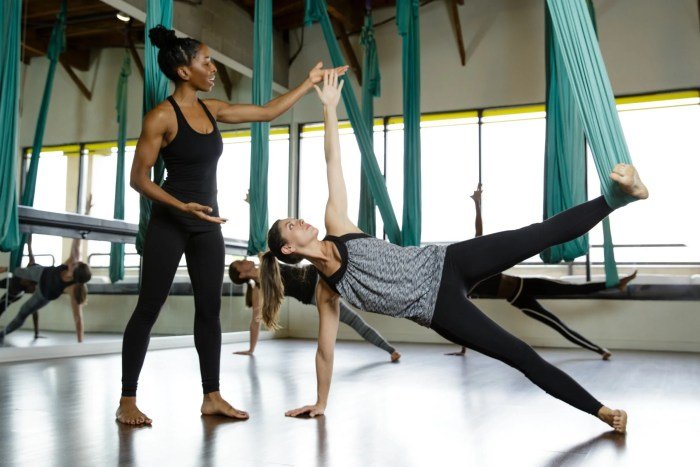
Air aerial fitness, with its unique blend of strength, flexibility, and artistry, can be enjoyed by a diverse range of individuals. This section explores how this exciting activity can be adapted to suit different age groups, fitness levels, and physical abilities.
We’ll also delve into the potential benefits of air aerial fitness for people with certain health conditions.
Adapting Air Aerial Fitness for Different Age Groups
The beauty of air aerial fitness lies in its adaptability. It can be tailored to meet the needs of individuals at various stages of life, from young children to older adults.
- Children: Air aerial fitness can be a fun and engaging way for children to develop strength, coordination, and flexibility. Classes designed specifically for children often incorporate games and playful activities, making it an enjoyable experience. Safety is paramount, with instructors carefully supervising and adapting techniques to suit their age and abilities.
- Teenagers: Air aerial fitness can be a great way for teenagers to build confidence, challenge themselves physically, and express their creativity. The dynamic nature of the activity can be particularly appealing to this age group, providing a fun alternative to traditional exercise.
- Adults: Air aerial fitness offers a wide range of benefits for adults of all ages and fitness levels. From beginners to seasoned athletes, there are classes and techniques to suit everyone. It can help improve strength, flexibility, balance, and cardiovascular health.
- Older Adults: Air aerial fitness can be a fantastic option for older adults looking to maintain their fitness and mobility. Modified techniques and specialized classes cater to their specific needs, focusing on gentle movements and promoting strength, flexibility, and balance.
Adapting Air Aerial Fitness for Different Fitness Levels
Air aerial fitness can be adapted to accommodate individuals with varying fitness levels, from beginners to advanced athletes.
- Beginners: Instructors will introduce basic techniques and movements gradually, building a strong foundation of strength and flexibility. Classes are designed to be accessible and enjoyable for newcomers, ensuring a positive experience.
- Intermediate: As individuals progress, they can explore more challenging techniques and sequences. Instructors will provide guidance and support, helping them to refine their skills and advance their abilities.
- Advanced: Experienced aerialists can push their limits and explore advanced techniques, such as intricate inversions, dynamic transitions, and complex aerial choreography. Classes cater to their advanced skill level, allowing them to challenge themselves further.
Adapting Air Aerial Fitness for Individuals with Specific Needs or Limitations
Air aerial fitness can be adapted for individuals with specific needs or limitations, ensuring everyone can participate and enjoy the benefits.
- Individuals with Physical Limitations: Instructors can modify techniques and provide alternative movements to accommodate individuals with physical limitations. For example, they might suggest using a chair or other support for certain poses or transitions. The focus is on finding ways to participate safely and effectively, adapting to individual needs.
- Individuals with Disabilities: Air aerial fitness can be a wonderful activity for individuals with disabilities. Instructors are trained to work with individuals with various disabilities, ensuring they can access the benefits of the activity. Modifications may include using adaptive equipment, adjusting the height of the apparatus, or providing additional support.
The goal is to create an inclusive environment where everyone can participate and feel empowered.
Benefits of Air Aerial Fitness for People with Certain Health Conditions
Air aerial fitness can offer numerous benefits for individuals with certain health conditions.
Air aerial fitness is a fantastic way to build strength, flexibility, and confidence. It’s a great workout that challenges you in a fun and unique way. While you’re working on your aerial skills, don’t forget to check out supreme beauty supply for all your hair and beauty needs.
They have a great selection of products to keep you looking and feeling your best, both on and off the silks.
- Osteoporosis: The weight-bearing nature of air aerial fitness can help to increase bone density, which can be beneficial for individuals with osteoporosis. The controlled movements and gentle stretches can also help to improve flexibility and balance, reducing the risk of falls.
- Arthritis: Air aerial fitness can help to improve joint mobility and flexibility, which can be beneficial for individuals with arthritis. The low-impact nature of the activity can reduce stress on joints, while the controlled movements can help to strengthen muscles surrounding the joints.
- Anxiety and Depression: Air aerial fitness can be a great way to reduce stress and improve mood. The physical activity releases endorphins, which have mood-boosting effects. The focus and concentration required for aerial fitness can also help to quiet the mind and reduce anxiety.
Air aerial fitness is a great way to get a full-body workout while having fun. It combines elements of dance, yoga, and gymnastics, challenging your strength, flexibility, and coordination. If you’re a federal employee, you may be eligible for health benefits plans that could help cover the cost of fitness activities, including air aerial fitness.
You can learn more about these plans by visiting federal employee health benefits plans. Once you’ve found a plan that suits your needs, you can start exploring the exciting world of air aerial fitness and discover the many benefits it offers.
- Chronic Pain: Air aerial fitness can help to improve strength, flexibility, and balance, which can be beneficial for individuals with chronic pain. The controlled movements and gentle stretches can help to reduce pain and improve mobility.
The Future of Air Aerial Fitness
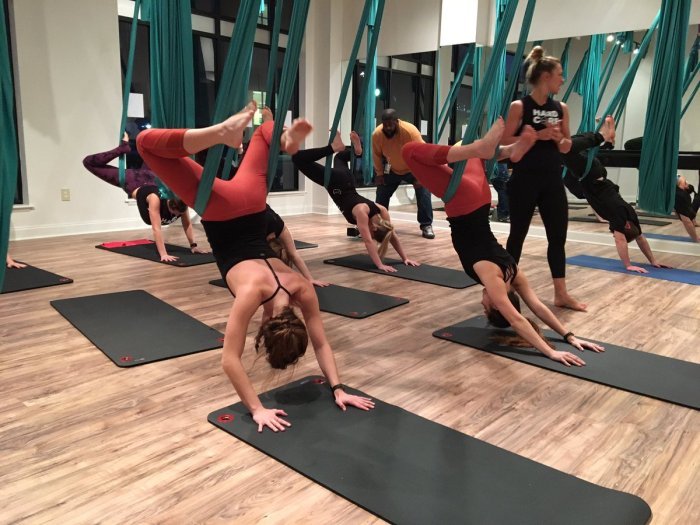
Air aerial fitness, with its captivating blend of strength, grace, and artistry, is poised for continued growth and evolution. The discipline is not only expanding in popularity but also undergoing exciting transformations, driven by innovation and the desire to make this exhilarating activity accessible to a wider audience.
Emerging Trends and Innovations
The future of air aerial fitness is marked by a dynamic interplay of emerging trends and innovative approaches.
- Integration of Technology: The fitness industry is embracing technology, and air aerial fitness is no exception. Interactive platforms, apps, and wearable devices are being developed to enhance training experiences. For example, apps could provide personalized workouts, track progress, and offer virtual coaching sessions, making it easier for individuals to learn and improve at their own pace.
- Focus on Accessibility: There’s a growing emphasis on making air aerial fitness accessible to individuals of all fitness levels and abilities. This includes offering beginner-friendly classes, modifications for specific needs, and equipment designed for diverse body types. For instance, some studios are now incorporating adjustable silks and aerial hoops that can be adapted to accommodate different heights and strengths.
- Cross-Training and Fusion Styles: The boundaries of air aerial fitness are blurring as it integrates with other disciplines. We’re seeing fusion styles emerge, combining elements of aerial arts with yoga, Pilates, dance, and even martial arts. This creates a more dynamic and engaging experience, appealing to a broader range of interests.
- Sustainability and Ethical Practices: The fitness industry is increasingly focused on sustainability and ethical practices. This trend is likely to influence air aerial fitness, with studios adopting eco-friendly materials for equipment, reducing their carbon footprint, and promoting ethical sourcing.
Increased Mainstream Appeal
The potential for air aerial fitness to become more mainstream is evident. Several factors contribute to this trend:
- Celebrity Endorsements: Celebrities have embraced air aerial fitness, showcasing its benefits and increasing its visibility. This exposure has piqued the interest of a wider audience, driving demand for classes and studios.
- Social Media Influence: Social media platforms like Instagram and TikTok are flooded with captivating videos of aerialists performing impressive feats. This visual appeal has sparked curiosity and encouraged individuals to explore the discipline.
- Growth of Fitness Studios: The number of fitness studios offering air aerial fitness classes is steadily increasing. This wider availability makes it easier for individuals to access classes and experience the benefits firsthand.
- Community Building: Air aerial fitness fosters a strong sense of community. Studios often host social events and workshops, creating a supportive environment where individuals can connect with like-minded enthusiasts.
Predictions for the Future
The future of air aerial fitness holds exciting possibilities:
- Specialized Training Programs: We can expect to see the development of specialized training programs catering to specific goals, such as strength training, flexibility improvement, or injury rehabilitation.
- Innovative Equipment: New and innovative equipment, such as smart silks and aerial hoops with integrated sensors, will enhance training experiences and provide real-time feedback.
- Global Expansion: Air aerial fitness is likely to continue its global expansion, with new studios opening in diverse locations and attracting a growing international community.
- Integration into Other Industries: The principles of air aerial fitness may be incorporated into other industries, such as physiotherapy, dance therapy, and even performance art.
Epilogue
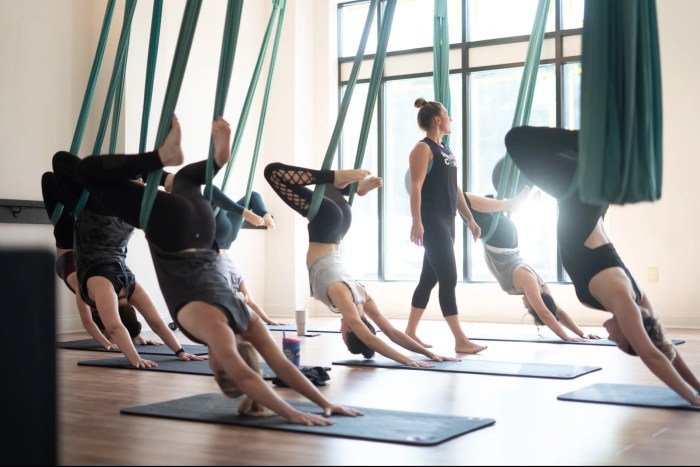
Air aerial fitness is more than just a workout; it’s an opportunity to challenge yourself, explore your physical potential, and connect with your inner strength. As you progress through your air aerial fitness journey, you’ll experience a sense of accomplishment, empowerment, and joy that comes from mastering new skills and pushing your boundaries.
Whether you’re a seasoned athlete or a fitness novice, air aerial fitness offers a unique and rewarding way to transform your body and mind.
Detailed FAQs
What are the risks associated with air aerial fitness?
As with any physical activity, there are inherent risks associated with air aerial fitness, including potential for falls, sprains, and strains. However, these risks can be minimized by choosing a qualified instructor, following safety guidelines, and starting with basic poses and gradually increasing difficulty.
Do I need any prior experience to try air aerial fitness?
No prior experience is necessary to try air aerial fitness. Many studios offer beginner-friendly classes that are designed to introduce participants to the basic techniques and skills. You’ll be guided by experienced instructors who will help you progress at your own pace.
How often should I practice air aerial fitness?
The frequency of your air aerial fitness practice will depend on your fitness goals and personal preferences. It’s generally recommended to start with one or two classes per week and gradually increase the frequency as you build strength and endurance.